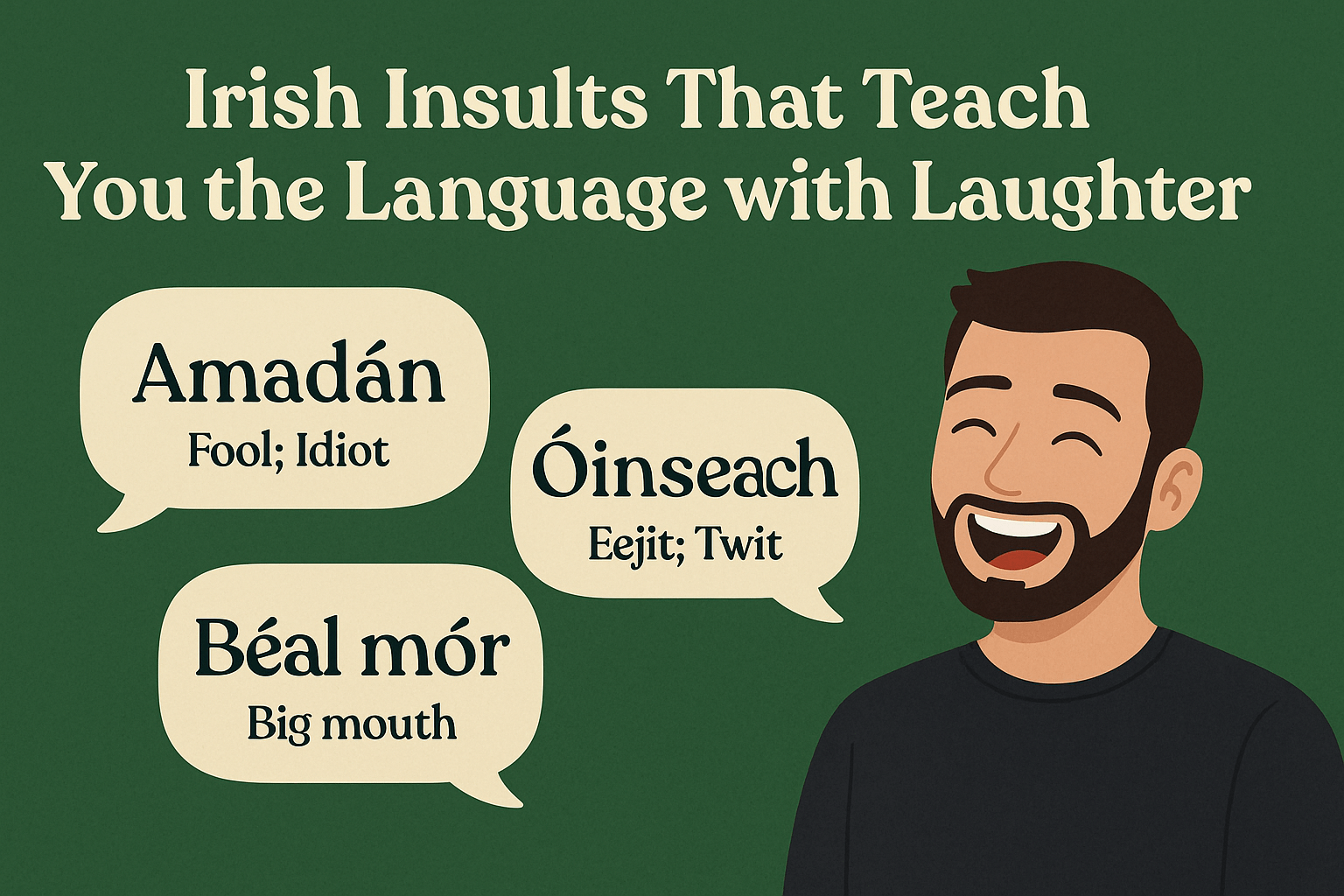Learning a new language doesn’t have to be all grammar drills and rote memorization—especially when that language is Irish. One of the most entertaining and surprisingly educational ways to deepen your Gaeilge is by exploring the world of Irish insults. These clever, cheeky expressions offer much more than comic relief—they provide real insights into pronunciation, structure, and Irish culture.
At Gaeilgeoir AI, we believe that laughter is a powerful language tool. So why not combine learning with a bit of Irish sass? In this guide, we’ll explore traditional and humorous Irish insults, explain their grammar and usage, and show you how they can actually help you become more fluent.
Why Learn Irish Insults?
1. They Stick in Your Memory
Let’s face it: You’re far more likely to remember “You haven’t the sense to wear your own shoes” than a dry textbook phrase. Irish insults are vivid, often poetic, and packed with personality.
2. They Teach Real Sentence Structure
Many insults use common Irish grammatical forms, such as the subjunctive mood or possessive structures. This makes them excellent practice material in disguise.
3. They Reflect Irish Humor and Culture
Insults in Irish aren’t usually mean-spirited—they’re witty, ironic, and often affectionate. Learning them gives you a deeper connection to the culture.
Hilarious (and Harmless) Irish Insults to Know
Here are some of the best-known and most creative Irish insults, with translations and pronunciation guides. Use them wisely—and only in good fun!
1. “Is amadán thú!”
Translation: You’re a fool!
Pronunciation: Iss ama-dawn hoo
This simple insult is commonly used among friends and siblings. Think of it as calling someone a “daft eejit.”
2. “Go n-ithe an cat thú is go n-ithe an diabhal an cat!”
Translation: May the cat eat you and may the devil eat the cat!
A famously theatrical curse that shows off Irish creativity. It’s usually said with a smirk.
3. “Tá do cheann chomh folamh le mála seacláide folamh.”
Translation: Your head is as empty as an empty bag of chocolate.
A clever insult that also doubles as a metaphor lesson.
4. “Níl ciall agat fiú do bhróga a chaitheamh.”
Translation: You haven’t the sense to wear your own shoes.
Harsh? Maybe. Funny? Absolutely.
5. “Is beag do leas i do léim.”
Translation: There’s little benefit in your jumping.
A subtle way to cut down on someone’s bragging.
The Grammar Behind the Guffaws
Each insult is also a mini grammar lesson. Here’s how:
- Subjunctive Mood:
“Go n-ithe an cat thú…” uses the subjunctive, common in blessings and curses. - Comparative Constructions:
“Chomh folamh le…” shows how to form similes with adjectives. - Possessive Forms:
“Do cheann” (your head) and “do bhróga” (your shoes) reinforce possessive structures.
Interested in digging deeper into how these grammar points work? Visit our detailed Irish sentence structure guide for a breakdown.
Using Irish Insults as a Learning Tool
🧠 Try the “Insult of the Day” Challenge
Post one on your fridge, desk, or phone. Say it aloud, learn its structure, and maybe text it to a language partner for a laugh.
🔊 Practice Pronunciation with AI
Use the pronunciation tools at Gaeilgeoir AI to perfect your delivery. These phrases can be tricky, but our speech recognition makes practice fun and accurate.
👉 Get started with our Irish pronunciation guide
🎯 Add Contextual Vocabulary
Pair each insult with a vocabulary session. For example, after learning “ceann” (head), explore related body parts or adjectives.
Looking for structured practice? Our Irish language lessons for beginners are a great place to build your foundation and sprinkle in fun extras like these along the way.
Keep It Playful, Keep It Respectful
It’s important to remember that while these insults are fun and often used jokingly, they should always be used with care:
- Stick to Safe Settings: Among friends or in fictional storytelling exercises.
- Learn First, Use Later: Understand the cultural tone before using any insult aloud.
- Never Personal: These expressions should be fun, not harmful.
More Irish Fun: Sayings, Flashcards, and Sass
Want more colorful language without crossing into rude territory? Check out our collection of Irish sayings in Gaelic or spice up your study sessions with cool Irish words to know.
For learners who like to mix education with entertainment, we also recommend creative ways to learn Gaeilge that include songs, stories, and yes—even a little smack talk.
Final Thoughts: Humor Makes You Fluent Faster
Adding humor to your Irish language journey is more than entertainment—it boosts memory, reinforces grammar, and makes learning joyful. With Irish insults, you’re not just being cheeky; you’re tapping into centuries of wit, tradition, and clever wordplay.
And the best part? You don’t have to learn alone.
🎉 Join hundreds of Gaeilge learners on our platform today.
👉 Start your free trial at Gaeilgeoir AI and explore Irish with confidence—and a bit of craic!
Slán go fóill, a dhuine cliste – farewell, you clever human


